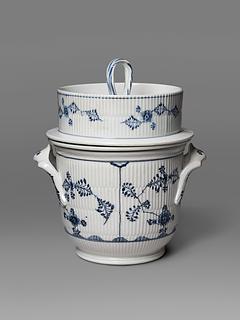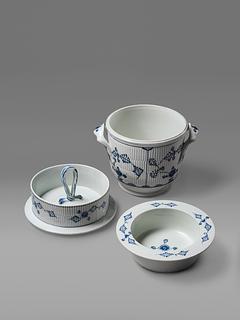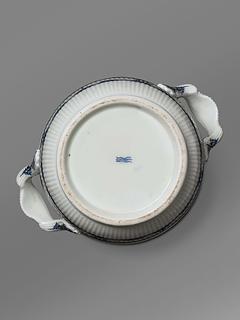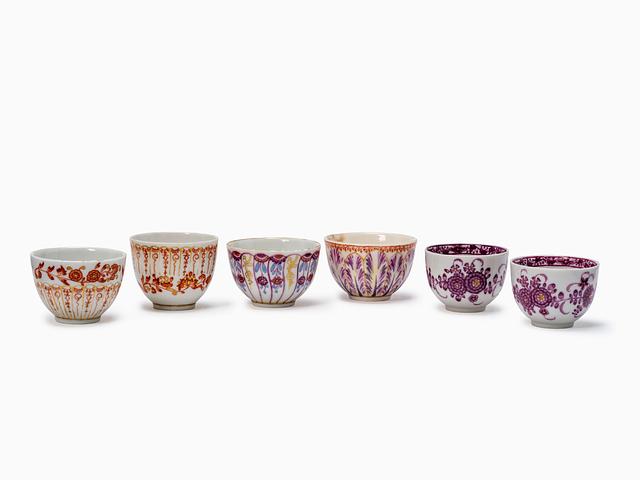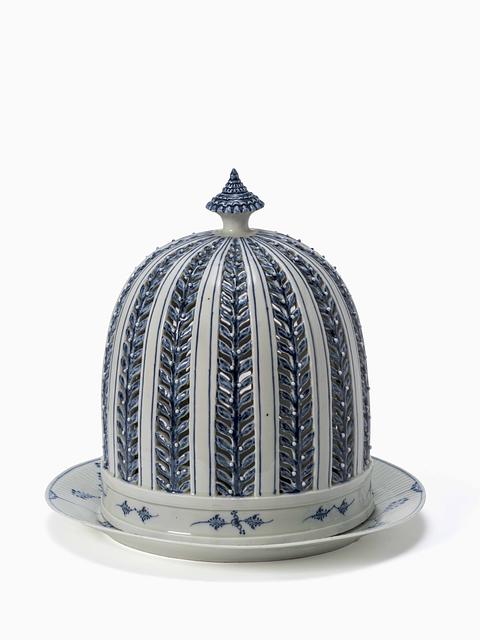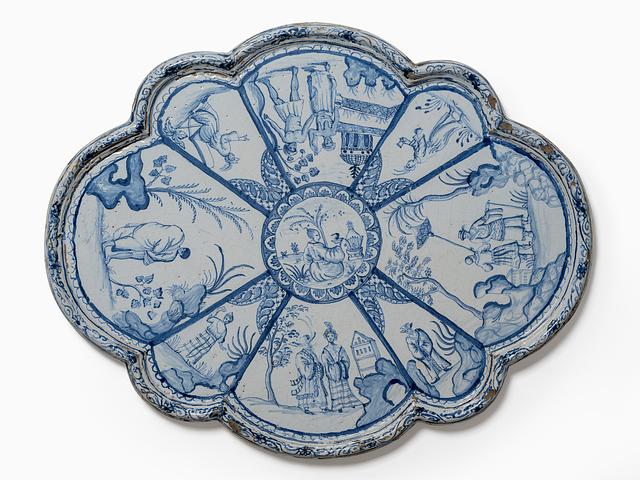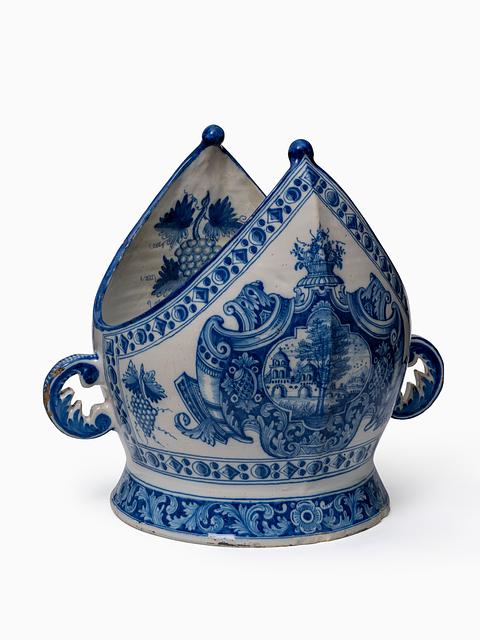Ice pot with casserole and lid; porcelain
Royal Copenhagen Porcelain Manufactory, 1790–1800
H: 23 cm
Inventory number KP 175
The Royal Copenhagen Porcelain Manufactory incorporated the ‘ice pot’ in several of their services, including their blue-and-white, underglaze-decorated porcelain – known as the Blue Fluted service. The complete ice pot – like this one in The David Collection – consisted of three parts, which, in addition to the pot itself, included a casserole and a lid with a handle. The ice pot could be used to cool smaller dishes, such as caviar, which was placed in the casserole while crushed ice was placed in both the lid and the pot. The ice pot alone could be used as a wine cooler.1
The form as well as the factory mark – the three waves – reveals that this ice pot was made in the years between 1790 and 1800. The blue decoration was done by the painter Lars Hansen, who was employed at the Royal Copenhagen Porcelain Manufactory for many years. This is evidenced by his signature which is two short parallel lines or arcs.
Several sources point out Lars Hansen as being the first ‘blue painter’ while also describing him as one of the most significant painters of the factory’s first years.2 Unfortunately, little is known about him, other than that he was a soldier before being employed at the factory in 1775, and that his version of the ‘Blue Fluted’ pattern evolved into an unusually beautiful and detailed design compared to those created by the other painters who also worked with blue decorations in the late eighteenth century.3
The form as well as the factory mark – the three waves – reveals that this ice pot was made in the years between 1790 and 1800. The blue decoration was done by the painter Lars Hansen, who was employed at the Royal Copenhagen Porcelain Manufactory for many years. This is evidenced by his signature which is two short parallel lines or arcs.
Several sources point out Lars Hansen as being the first ‘blue painter’ while also describing him as one of the most significant painters of the factory’s first years.2 Unfortunately, little is known about him, other than that he was a soldier before being employed at the factory in 1775, and that his version of the ‘Blue Fluted’ pattern evolved into an unusually beautiful and detailed design compared to those created by the other painters who also worked with blue decorations in the late eighteenth century.3
Published in
Published in
Bredo L. Grandjean: Kongelig Dansk Porcelain: 1775-1884, København 1962, p. 231;
Dansk kunst og kunsthåndværk, Davids Samling, København 1972, p. 32 and pl. 9;
Verner Jul Andersen: Dansk kunst og kunsthåndværk, Davids Samling, 2.ed., København 1983, cat. 94, p. 37;
Lauritz G. Dorenfeldt: Kongeligt porcelæn 1775-1820: blåmalet porcelæn fra Den Kongelige Porcelainsfabrik, København 2004, pp. 59 and 64;
Dansk kunst og kunsthåndværk, Davids Samling, København 1972, p. 32 and pl. 9;
Verner Jul Andersen: Dansk kunst og kunsthåndværk, Davids Samling, 2.ed., København 1983, cat. 94, p. 37;
Lauritz G. Dorenfeldt: Kongeligt porcelæn 1775-1820: blåmalet porcelæn fra Den Kongelige Porcelainsfabrik, København 2004, pp. 59 and 64;
Footnotes
Footnotes
1.
Lauritz G. Dorenfeldt: Kongeligt porcelæn 1775-1820: blåmalet porcelæn fra Den Kongelige Porcelainsfabrik, Copenhagen 2004, pp. 106–110 and 117.
2.
These include Karl Madsen, Victor P. Christensen, Bredo L. Grandjean and Lauritz G. Dorenfeldt, all of whom have written about the history of Danish porcelain.
3.
Bredo L. Grandjean: Kongelig Dansk Porcelain: 1775-1884, Copenhagen 1962, p. 231.
